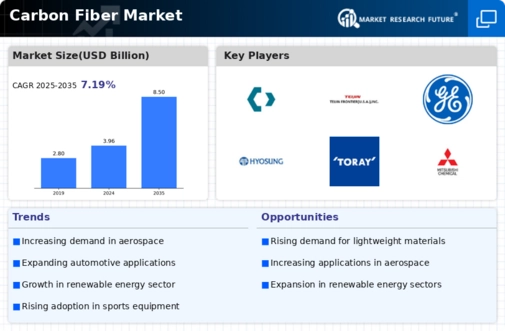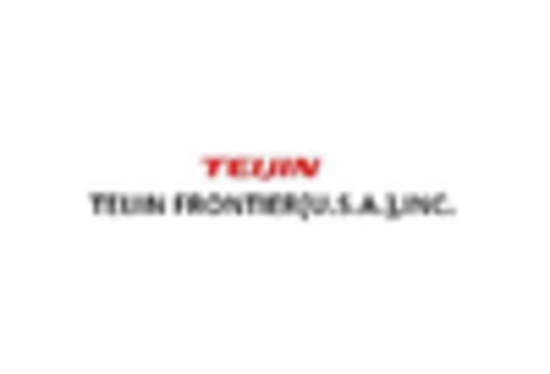Rising Demand in Aerospace Sector
The aerospace sector is experiencing a notable increase in demand for lightweight and high-strength materials, which positions the Carbon Fiber Market favorably. Carbon fiber composites are increasingly utilized in aircraft manufacturing due to their superior strength-to-weight ratio, which enhances fuel efficiency and performance. Reports indicate that the aerospace industry is projected to grow at a compound annual growth rate (CAGR) of approximately 4.5% over the next five years. This growth is likely to drive the demand for carbon fiber components, as manufacturers seek to reduce overall aircraft weight and improve operational efficiency. Consequently, the Carbon Fiber Market is expected to benefit significantly from this trend, as more aerospace companies adopt carbon fiber materials in their designs and production processes.
Automotive Industry Transformation
The automotive industry is undergoing a transformation, with a marked shift towards lightweight materials to enhance fuel efficiency and reduce emissions. The Carbon Fiber Market is poised to capitalize on this trend, as carbon fiber composites are increasingly integrated into vehicle designs. Recent data suggests that the use of carbon fiber in automotive applications could grow at a CAGR of around 10% over the next several years. This growth is driven by the rising demand for electric vehicles (EVs) and the need for improved performance and safety features. As automotive manufacturers prioritize sustainability and efficiency, the adoption of carbon fiber materials is likely to expand, thereby bolstering the Carbon Fiber Market.
Advancements in Manufacturing Technologies
Innovations in manufacturing technologies are playing a crucial role in the evolution of the Carbon Fiber Market. Techniques such as automated fiber placement and 3D printing are enhancing production efficiency and reducing costs associated with carbon fiber components. These advancements enable manufacturers to produce complex geometries and customized solutions that meet specific industry requirements. As production processes become more streamlined, the accessibility of carbon fiber materials is likely to increase, attracting a broader range of industries. The Carbon Fiber Market may witness a surge in demand as these technologies continue to evolve, making carbon fiber more competitive against traditional materials.
Expansion of Sports and Recreational Equipment
The sports and recreational equipment sector is witnessing a surge in demand for high-performance materials, positioning the Carbon Fiber Market for growth. Carbon fiber is favored for its lightweight and high-strength characteristics, making it ideal for various sporting goods, including bicycles, golf clubs, and fishing rods. Market analysis indicates that the sports equipment segment is expected to grow at a CAGR of approximately 6% over the next few years. This growth is driven by consumer preferences for advanced materials that enhance performance and durability. As manufacturers continue to innovate and incorporate carbon fiber into their products, the Carbon Fiber Market is likely to experience increased demand and expansion.
Growing Interest in Renewable Energy Solutions
The shift towards renewable energy solutions is fostering growth in the Carbon Fiber Market. Wind energy applications, particularly in turbine blade manufacturing, are increasingly utilizing carbon fiber composites due to their lightweight and durable properties. The wind energy sector is projected to expand significantly, with investments in renewable energy expected to reach trillions of dollars in the coming years. This trend suggests a robust demand for carbon fiber materials, as manufacturers seek to enhance the efficiency and longevity of wind turbine components. Consequently, the Carbon Fiber Market stands to benefit from the increasing integration of carbon fiber in renewable energy applications.

















Leave a Comment